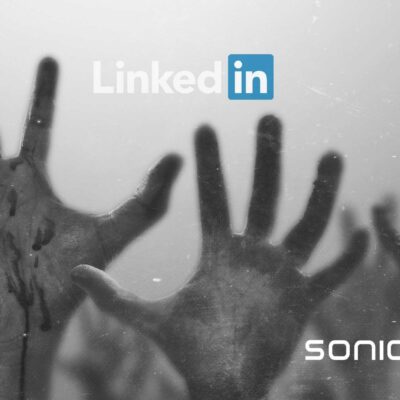The Metaverse is supposed to introduce the next internet revolution. Christoph Kullnig, Head of Group Marketing at Raiffeisen Bank International, explains in an interview with sonicboom what the chances are that it will become a dystopia or a utopia.
The metaverse is to become the new reality. And it is digital. People meet mainly virtually and buy virtual properties with real money. Blockchain technology makes all this possible. A digital revolution, in other words. Christoph Kullnig knows all about that. He was already responsible for the rise of Runtastic as a manager and now works as Head of Group Marketing at Raiffeisen Bank International.
Marc Zuckerberg recently brought the issue back into the spotlight when he renamed his Facebook group Meta. At the same time, he announces that he is working on a metaverse in which the real and digital worlds are to mix. However, the term did not originate with Zuckerberg – the metaverse has existed in novels and films for decades. While Silicon Valley believes in a utopia, in popular culture (from Lawnmower Man to Total Recall to Matrix) it always ends in a dystopia.
In an interview with Christoph Kullnig, sonicboom dares to take a look at Web 3.0, its opportunities, and risks.
Who is META aimed at?
Just because Facebook is now called Meta, nothing has changed. The same products still exist – WhatsApp, Messenger, Instagram, and Facebook. These four essential components remain unchanged. The target groups of the respective applications are different, and the content is different. Facebook and Instagram are a community, and WhatsApp and Messenger are for communication. The renaming probably has mainly marketing reasons and legal background. If you have a common platform, it is probably easier to exchange data.
The renaming is a step towards the metaverse. What is that?
We had Web 1.0 – where people just wanted to find information. Then came Web 2.0, which Facebook started. Users can share things, comment, and create content themselves. Now we are in Web 3.0. The essential progress is that there is now also ownership and property in the virtual space. The crucial technology is the blockchain. It is the enabler for Web 3.0 and its various applications. So NFT, Crypto, or inventions that are yet to come.
What role does meta play in this?
Meta wants a piece of this pie and to open up new business models for it. But this has nothing to do with Facebook or Instagram. There will be something new, something decentralized. But many will try that. Even Google, Apple and all the big tech companies. The metaverse is a parallel economy, not a parallel world. Because a parallel world already exists, but it is now being supplemented by economic aspects. Play-to-earn already exists in gaming. Zuckerberg also wants to be part of it. It is very clever that he calls his company Meta. The name is taken.
What will Web 3.0 look like?
The result will be that a few companies will own Web 3.0. It will be monopolized. That’s how globalization works – money and power concentrate. However, the basic idea of the metaverse and the blockchain are decentralization, the exact opposite. I personally believe there will be a parallel universe where we will all be. There is no place for two or four providers, as is the case now with social media applications. The metaverse works differently.
Who are the users?
I’m too old for that, I’m Generation X. There is a study that asked where people feel more comfortable. In the real world or in the digital world. Generation Z was the first, the majority of whom feel more comfortable in the digital world. According to their own statement, they can be themselves there more. Among Generation Y, 46 percent already felt more comfortable in the digital world. This makes it easy to predict where the trend is going.
Since the audience is so young, does it make sense for you and me to talk about it?
As a private person, I don’t want to live in a digital parallel world. But I believe that people will choose to do so. Could there be a split in society? Probably yes.
A business plan like something out of a sci-fi movie.
I like Hollywood quite a lot. Because they predict developments 30 or 40 years earlier. Electric cars, for example. A few filmmakers believed that soon we’d all be driving one. Now we have arrived at “The Matrix” and the film is from 1999.
The term “metaverse” comes from a 1991 novel and was a dystopia. Is this what is coming to us? Why has this name been adopted?
Some people overestimate the people at the big tech companies. I don’t know if they know the book or how they came up with the name. But Silicon Valley is certainly not dystopian in tone, but rather utopian. If the term is rather negatively charged, they try to give the name a positive connotation.
Does that work?
Who knows. I think it’s 50 percent likely that it will be a dystopia. Because I don’t think the development of a parallel universe is right. Facebook had added value. And the Metaverse, in my opinion, also has benefits, but also more dangers. On the other hand, I’m in the target group for Facebook, but not for the Metaverse.
Many disruptive ideas owe their breakthrough to a physical invention. For the mobile age as we know it, we need the iPhone 3G and the app store. What is the Metaverse missing?
The new invention already exists, which is essentially the blockchain. But in order to be able to scale it, a platform is needed. A portal that makes Web 3.0 suitable for the masses. In the past, there was My Space and Studi VZ in addition to Facebook, but then the market consolidated. There are already meta browsers, but not yet the ‘Facebook’ or ‘Google’ of Web 3.0. Access is the most important thing.
How long will it take until we are all in Web 3.0?
100 percent of all people will never be inside. But for the people for whom it is relevant – Generation Z and Alpha – it will probably be ready for the masses in two to four years. The early adopters are already there, the first followers still need a year.
How long will it take until we are all in Web 3.0?
For companies, it is a channel where customers can be addressed. A community will come together there, where people trade and where there is ownership. For companies, the first step will be to address these people. Most companies don’t do business there, but are only present and thus have another touchpoint.
And in the second step?
There will soon be products that can only be bought in the metaverse. I don’t believe that retail will remain hybrid. Now people are still advertising on Web 3.0, but the actual business is then done in the real world because customers don’t want to buy a digital Rolex or a virtual Adidas shirt. But this will soon become a trend. The Rolex will soon cost as much in the metaverse as it does in the real world. That will happen brutally fast.
How does Raiffeisen Bank International deal with this?
At the moment, the Metaverse is potential marketing upsell. In the Raiffeisen International network – which consists of 13 banks – there is Tatrabank, which is already very active in this area. They even have their own influencer for the Metaverse, Bejby Blue. We are considering whether sponsorship could be an issue. For example, an e-sports team, perimeter advertising at digital competitions, or hosting a match. One of the questions is whether we want to enter the economic system. There are many unanswered questions in that area. Cryptocurrencies and tokens are an important part of the metaverse. If you can’t use it, you’re not needed there. As long as the regulatory framework is not clear, no bank will make it in the metaverse.
That can happen quickly.
That’s right. That’s why you have to do your homework. We have innovation hubs where we try things out. Whether we then press the button and go live is another question. It’s still just marketing.
About Christoph Kullnig
Christoph Kullnig is a marketing executive, corporate manager and goal-oriented entrepreneur from Austria. He is Head of Group Marketing at Raiffeisen Bank International AG. Together with his team, he is responsible for strategic brand management and marketing in the RBI Group, the CEE network banks and the Austrian subsidiaries.
With more than 15 years of experience in branding & marketing, Christoph Kullnig gained leadership experience at the Paysafe Group, Runtastic GmbH, J.Lindeberg and the Austrian Armed Forces before joining Raiffeisen Bank International. He is particularly passionate about topics such as brand strategy, digitalisation, data, leadership, purpose and customer experience. He is passionate about passing on his knowledge to students at the Technikum Wien Academy.




